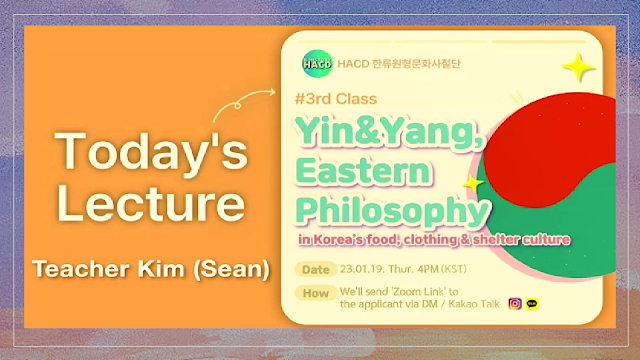[LESSON 3] Yin&Yang, Eastern Philosophy in Korea's food, Clothing and Shelter Culture.
[3rd SESSION] Yin&Yang and Eastern Philosohy
Good day and greetings to all of our beloved readers!
Thank you so much for coming to the HACD blog! It's another day filled with fantastic stories from us.
We are delighted to welcome you and express our gratitude for your time spent reading our blog.
Following several days of preparation, we meet again on the third session for Season 1 Lesson 3 and the lesson topic that we discussed is about Yin&Yang, Eastern Philosophy in Korean Food, Clothing, and Shelter Culture. It's encouraging to see how committed all of the participants are to continuing to attend our free lessons for everyone; we believe they are enjoying and appreciate the learning experiences that we provide for them. In this lesson for the third week of our regular meeting, Teacher Seok Kim was selected as the lecturer for the class topic; he is one of the organization's greatest teachers and interpreters. So, with the most active engagement of our participants, we effectively filled week 3 with understanding and a lot of energy Most of the time, we noticed our participants taking notes on essential and insightful teachings, and they always provided excellent feedback afterwards the session was over.
So here are the highlights from our third meeting's lesson 3. Every week, numerous attendees from various countries join us to study together to gain knowledge about cosmology and dao 'the path', the law of yin and yang 'it refers to the fact that everything has a significant other and to balance all things. For instance, Heaven and Earth, Light and Darkness, and the ideal representation is animals and plants. We also discussed the four laws of Yin and Yang: [1] Yin and Yang coexist, [2] Yin and Yang supplement and support one another, [3] Yin and Yang directly oppose and restrict one another, and [4] Yin and Yang alternate in circulation. Yin and Yang represent the concept that anything and everything can be divided into two; the universe is so big that we must delve deeper and study in tiny parts to gain a better grasp of it. We also discussed the five aspects that pertain to the East and West. The four classical elements are Air, Earth, Fire, and Water in the West, and the western zodiac sign has its origins while in the East, where we have the time-tested philosophy of the five elements of Wood, Fire, Earth, Metal, and Water.

Following that, we discussed Hado, Nakseo, and the five element's life cycles. The most fascinating part is that a great deal of the lectures are related to the K-drama movies and music that we watch and listen, so it's even more exciting that we can truly comprehend the contents of the movies and music that we keep an eye on, and we can realize matters much more by studying deeply with HACD. It also claims that Korean cosmology is present everywhere and that Koreans apply their cosmology in all aspects of their lives. Koreans have historically believed that humans originated in the heavens, or the stars, and that every human being will eventually return there as well. "In essence, we are all children of heaven and earth; we come from and return to heaven and earth." Successfully, that brings us to the conclusion of Lesson 3.
Additionally, it's because Seollal, or "Korean New Year," a traditional celebration and national holiday celebrated every year, our hosts, Mentor Jeonghae and MC Naya, are dressed in and representing traditional Korean clothing and accessories, the Hanbok. We were pleasantly surprised that almost every one of the participants asked a lot of questions about the topic, indicating that they are interested and would like to learn more about it for a better understanding. Most of the attendees gave positive feedback about the lesson that we held for lesson 3, and it's so nice that they also enjoyed the classes. Thanks to our great lecturer for delivering the lesson in a very easy-to-understand and straightforward way, and thanks to our mentors for leading and helping the participants in making better grasp of it.
Stay with us and let's continue to read HACD blog together! Another session will begin, so stay and patiently wait for the amazing part, as the following activity will be "News Card Presentation." Then let us look forward to it soon! Thank you for taking the time to read our article and visiting our blog; we appreciate it. We hope you found it useful and interesting! Did you find enjoyable what you read on our blog? If so, please leave a comment below or follow us on our specific social media platforms.
"WE VALUE YOUR EFFORTS & SUPPORT"
Thank you for taking the time to read this article; we hope you found it informative and interesting! We hope you will come along with us. You are warmly encouraged to forward this article to your friends! Please visit our websites, follow & subscribe, and take a moment to check it out. Did you find it fascinating and remarkable? You can contact us via our Instagram accounts, post comments on our YouTube channel, or leave feedback in the comment box below.
Here are the links to HACD's Instagram and YouTube accounts:
INSTAGRAM:
HACD Korean - https://www.instagram.com/hansadan.official/
HACD YouTube - m.youtube.com/@hansadan
We will make your life meaningful by collaborating together.









댓글
댓글 쓰기